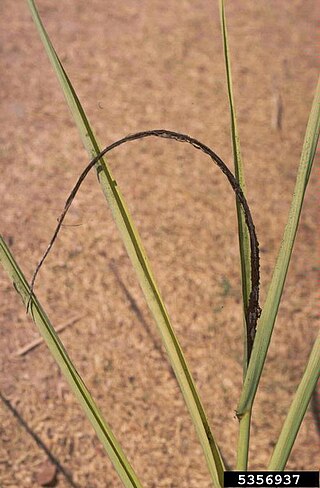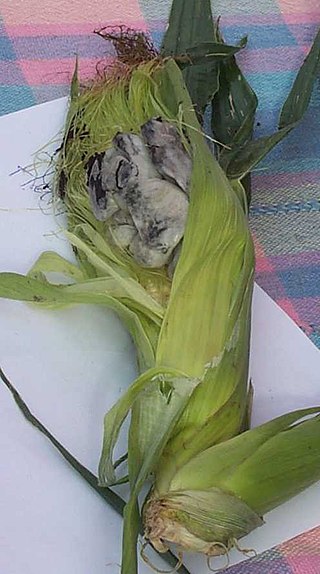
In biology, a spore is a unit of sexual or asexual reproduction that may be adapted for dispersal and for survival, often for extended periods of time, in unfavourable conditions. Spores form part of the life cycles of many plants, algae, fungi and protozoa.

Heinrich Anton de Bary was a German surgeon, botanist, microbiologist, and mycologist . He is considered a founding father of plant pathology (phytopathology) as well as the founder of modern mycology. His extensive and careful studies of the life history of fungi and contribution to the understanding of algae and higher plants established landmarks in biology.
Blight refers to a specific symptom affecting plants in response to infection by a pathogenic organism.

Corn smut is a plant disease caused by the pathogenic fungus Ustilago maydis. One of several cereal crop pathogens called smut, the fungus forms galls on all above-ground parts of corn species such as maize and teosinte. The infected corn is edible; in Mexico, it is considered a delicacy called huitlacoche, often eaten as a filling in quesadillas and other tortilla-based foods, as well as in soups.

The smuts are multicellular fungi characterized by their large numbers of teliospores. The smuts get their name from a Germanic word for 'dirt' because of their dark, thick-walled, and dust-like teliospores. They are mostly Ustilaginomycetes and comprise seven of the 15 orders of the subphylum. Most described smuts belong to two orders, Ustilaginales and Tilletiales. The smuts are normally grouped with the other basidiomycetes because of their commonalities concerning sexual reproduction.

Ustilago is a genus of approximately 200 smut fungi, which are parasitic on grasses. 170 species are accepted by Wijayawardene et al. 2020;

Sugarcane smut is a fungal disease of sugarcane caused by the fungus Sporisorium scitamineum. The disease is known as culmicolous, which describes the outgrowth of fungus of the stalk on the cane. It attacks several sugarcane species and has been reported to occur on a few other grass species as well, but not to a critical amount. The most recognizable characteristic of this disease is a black or gray growth that is referred to as a "smut whip". Resistance to sugarcane smut is the best course of action for management, but also the use of disease free seed is important. On smaller scale operations treatments using hot water and removing infected plants can be effective. The main mode of spore dispersal is the wind but the disease also spreads through the use of infected cuttings. Sugarcane smut is a devastating disease in sugarcane growing areas globally.

The Ustilaginales are an order of fungi within the class Ustilaginomycetes. The order contained 8 families, 49 genera, and 851 species in 2008.

Loose smut of barley is caused by Ustilago nuda. It is a disease that can destroy a large proportion of a barley crop. Loose smut replaces grain heads with smut, or masses of spores which infect the open flowers of healthy plants and grow into the seed, without showing any symptoms. Seeds appear healthy and only when they reach maturity the following season is it clear that they were infected. Systemic fungicides are the major control method for loose smut.

Tilletia caries is a basidiomycete that causes common bunt of wheat. The common names of this disease are stinking bunt of wheat and stinking smut of wheat. This pathogen infects wheat, rye, and various other grasses. T. caries is economically and agriculturally important because it reduces both the wheat yield and grain quality.
Tilletia controversa is a fungal plant pathogen. It is a fungus known to cause the smut disease TCK smut in soft white and hard red winter wheats. It stunts the growth of the plants and leaves smut balls in the grain heads. When the grain is milled the smut balls emit a fishy odor that lowers the quality of the flour.

Urocystis agropyri is a fungal plant pathogen that causes flag smut on wheat.
Sporisorium sorghi, commonly known as sorghum smut, is a plant pathogen that belongs to the Ustilaginaceae family. This fungus is the causative agent of covered kernel smut disease and infects sorghum plants all around the world such as Sorghum bicolor (sorghum), S. sudanense, S. halepense and Sorghumvulgare var. technichum (broomcorn). Ineffective control of S. sorghi can have serious economic and ecological implications.
Sporisorium reilianum Langdon & Full., (1978), previously known as Sphacelotheca reiliana, and Sporisorium reilianum, is a species of biotrophic fungus in the family Ustilaginaceae. It is a plant pathogen that infects maize and sorghum.
Puccinia pittieriana is a species of rust fungus. It is a plant pathogen which infects agricultural crops such as potato and tomato. Its common names include common potato rust and common potato and tomato rust.
Thecaphora is a genus of basidiomycote fungus which contains several species of plant pathogens. The widespread genus contained about 57 species in 2008. and held 61 species in 2020.
Tilletia horrida, rice kernel smut, caryopsis smut, black smut, or grain smut, is a fungal rice disease believed to only affect the Oryza genus. It presents as a partial bunt.

Roland Thaxter was an American mycologist, plant pathologist, botanist, and entomologist, renowned for his contribution to the insect parasitic fungi—Laboulbeniales. His college education was completed at Harvard, where he dedicated forty years to mycological and botanical research. His five-volume series on fungi in the order Laboulbeniales laid a solid foundation of research on these insect ectoparasites. He also contributed to the field of Plant Pathology.

Salmacisia is a fungal genus in the family Tilletiaceae. It is a monotypic genus, containing the single species Salmacisia buchloëana, first described as Tilletia buchloëana in 1889, and renamed in 2008. Plants infected by the fungus undergo a phenomenon known as "parasitically induced hermaphroditism", whereby ovary development is induced in otherwise male plants. Because of the pistil-inducing effects of the fungus, the authors have named the species pistil smut; it is the only species in the order Tilletiales known to have hermaphroditic effects.

Daniel McAlpine was a Scottish-born Australian mycologist known for his research in plant pathology. He wrote several publications on plant disease in many crops and other plants. McAlpine was a lecturer in biology at the University of Melbourne from 1884, and, with his appointment to the Victorian Department of Agriculture from 1890 to 1911, became the British Empire's first professional plant pathologist.














